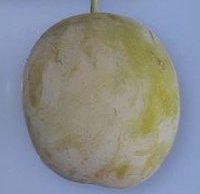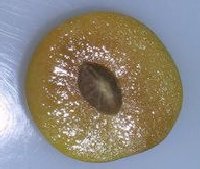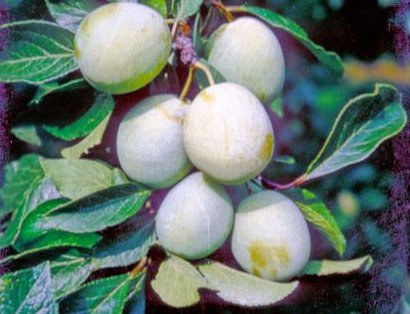PARENTAGE OF JEFFERSON PLUM TREE
The parents of Jefferson are unknown, it is believed to be a seedling with one of the possible parents being Coes Golden Drop. It originated from Albany in New York, this is decidedly American and was imported to the UK in 1841.
APPEARANCE, TASTE AND CHARACTERISTICS OF JEFFERSON
Jefferson is a tree with medium to vigour so it does best of a St Julien A rootstock if you want a manageable tree of about 4m/ 13ft height, less if pruned slightly harder than normal. Grow it on a less vigorous rootstock such as Pixy or VVA-1 and it will be a perfect container grown tree.
The fruits have a slightly tough skin but the inside is one the juiciest and sweetest of all. The texture is reasonably firm keeping most of the juice in your mouth rather than on your chin! This really is in the top five plum trees as far as taste is concerned.
The skin is a dull green / yellow and despite the description this an attractive looking plum. The flesh is a similar colour and slightly on the firm side. The stone in the middle is smallish and easy to remove. The overall size of the plum is about average.
In a typical year the fruits will ripen over a ten day period making this one of the longer cropping varieties of plums. This is ideal because it extends the cropping time and avoids the glut so common with most other varieties.
Jefferson is in pollination group 2 and cannot fertilise itself therefore needs a suitable pollination partner. Czar, Denniston’s Superb, Marjorie’s Seedling, Victoria and Warwickshire Drooper are well known varieties which will pollinate Jefferson very well. See the end of this article for when it will blossom and produce fruit in your area of the
UK.
Avoid growing this plum tree in the coolest parts of the UK because it does not appreciate very late frosts. But anywhere with a general climate similar to the Midlands and southwards will suit it just fine.
Ripe Jefferson plums
Pictures from public sector information licensed under the Open Government Licence v2.0.
POLLINATION PARTNERS FOR JEFFERSON PLUM TREES
Jefferson plum trees are in pollination group 2 and is self-sterile so needs a pollination partner nearby. The following varieties are good pollination partners:
- Avalon – pollination group 2, partially self-fertile
- Belle de Louvain – pollination group 3, self-fertile
- Cambridge Gage – pollination group 3, partially self-fertile
- Czar – pollination group 3, self-fertile
- Denniston’s Superb – pollination group 2, self-fertile
- Excalibur – pollination group 2, partially self-sterile
- Farleigh – pollination group 3, self-fertile
- Haganta – pollination group 3, partially self-fertile
- Herman – pollination group 2, self-fertile
- King Damson – pollination group 2, self-fertile
- Langley Bullace – pollination group 3, self-fertile
- Merryweather – pollination group 3, self-fertile
- Opal – pollination group 3, self-fertile
- Reine Claude de Bavay – pollination group 3, self-fertile
- Rivers Early Prolific – pollination group 2, partially self-fertile
- Sanctus Hubertus – pollination group 2, self-sterile, needs another pollination partner
- Shropshire Prune – pollination group 3, self-fertile
- Victoria – pollination group 3, self- fertile
- Warwickshire Drooper – pollination group 2, self-fertile
- Yellow Pershore – pollination group 2, self-fertile
BUYING A JEFFERSON PLUM TREE
Jefferson is available in larger garden centres and those which specialise in fruit trees. It is not normally available in supermarkets and DIY centres. It is widely available online.
SUMMARY CHARACTERISTICS OF JEFFERSON
USE: Eating plum
SKIN COLOUR / TEXTURE: Yellow / green with areas of light pink
FLESH COLOUR: Gold / yellow
TASTE AND TEXTURE: Moderately firm fruit, very juicy, sweet and full-tasting
FRUIT SIZE: Average
TREE SIZE: Average size depending on rootstock and conditions
REGULARITY OF CROPPING: Produces a good crop most years
POLLINATION: Group 2, self-sterile, requires a suitable pollination partner
AWARDS: RHS AGM
SPECIAL FEATURES: Superb taste and texture as an eating plum. Crops over a longer period compared to most other plum trees
FLOWERING AND FRUITING TIMES FOR JEFFERSON PLUM TREES
The average flowering time (optimum time for pollination) and date when fruits are ripe in the UK for the Jefferson plum tree are set out below. If you have set your home town we can give you a more accurate estimate, if you have not set your home town (do it now by clicking here) the dates below will be the average for the UK.
Your town has not been set, the average main flowering time for Jefferson
in the UK is the second week of April. Fruit will be ready for picking in the fourth of August.
Click here if you want to set the dates to your home town.
Flowering and fruit picking dates vary according to the weather in any particular growing season so the above dates may well change slightly from one year to the next. The flowering date above is when the plum tree produces the maximum number of blossoms, it will also produce blossom, although less, a week or two either side of the date given.



Rootstocks and Size
Pests and Disease
Guide to Planting
Pollination Groups
Care Plan and Pruning
Pruning Older Plum Trees
Top Ten Plum Tree Varieties
Plum Tree Questions and Answers
JEFFERSON PLUM TREE
By David Marks
Some experts in the world of plums claim to be able to distinguish a plum from a gage but in reality the distinction is so blurred that it’s wiser to avoid entering into that discussion. The Jefferson plum / gage is a perfect example of the problem, it has some of the so-called qualities of a plum and some of a gage. We’ll call it a plum for the purposes of this article.
Forget its classification, this is a superb tasting plum which is tops as far as sweetness and texture are concerned. It stands out from other plums because it crops over a long period of about ten days which is unusual as far as plum trees are concerned